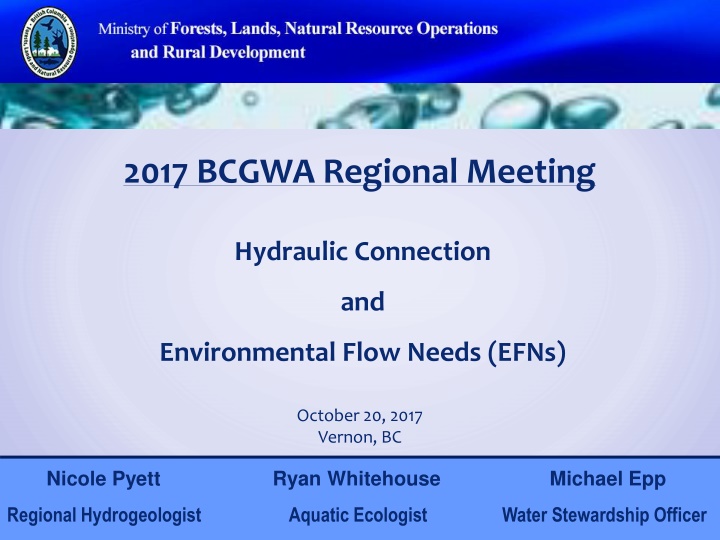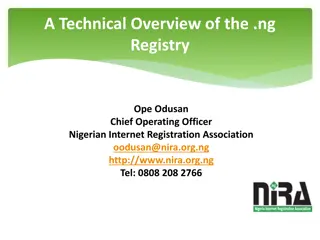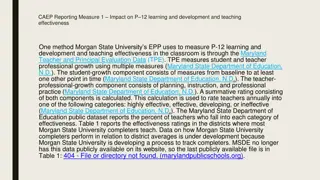
Hydraulic Connectivity and Environmental Flow Needs in Water Management
This document delves into the concepts of hydraulic connectivity, water licensing applications, and environmental flow needs in the context of water resource management. It covers topics such as determining hydraulic connection likelihood, considerations for water license reviews, assessment of environmental flow needs, and the licensing application process. The aim is to provide insights for decision-makers to ensure sustainable water allocation and use while safeguarding environmental interests.
Download Presentation

Please find below an Image/Link to download the presentation.
The content on the website is provided AS IS for your information and personal use only. It may not be sold, licensed, or shared on other websites without obtaining consent from the author. If you encounter any issues during the download, it is possible that the publisher has removed the file from their server.
You are allowed to download the files provided on this website for personal or commercial use, subject to the condition that they are used lawfully. All files are the property of their respective owners.
The content on the website is provided AS IS for your information and personal use only. It may not be sold, licensed, or shared on other websites without obtaining consent from the author.
E N D
Presentation Transcript
2017 BCGWA Regional Meeting Hydraulic Connection and Environmental Flow Needs (EFNs) October 20, 2017 Vernon, BC Nicole Pyett Ryan Whitehouse Michael Epp Regional Hydrogeologist Aquatic Ecologist Water Stewardship Officer
Outline | Hydraulic Connectivity | Licensing Application | Environmental Flow Needs | Summary OUTLINE: Hydraulic connectivity Water Science Series: Determining the Likelihood of Hydraulic Connection Hydraulic connection in the Okanagan Licensing application process Water license reviews Consideration of hydraulic connectivity/EFNs in a water license review Environmental flow needs (EFNs) Assessment of EFNs Types of advice for Statutory Decision Makers (SDMs) Summary and questions
Outline| Hydraulic Connectivity | Licensing Application | Environmental Flow Needs | Summary Hydraulic connection , for the purpose of water allocation and use, means the reasonable likelihood that pumping of groundwater from a well will eventually result in a change in the flow of a stream or spring or change in the level of a lake, pond, wetland that overlies or borders the aquifer, over a time period and to an extent that the decision maker must take into account in considering the environmental flow needs of the stream or whether the rights of other authorized users on the stream are likely to be detrimentally affected. Barlow and Leake, 2012
Outline| Hydraulic Connectivity | Licensing Application | Environmental Flow Needs | Summary HYDRAULIC CONNECTIVITY
Outline| Hydraulic Connectivity | Licensing Application | Environmental Flow Needs | Summary
Outline| Hydraulic Connectivity | Licensing Application | Environmental Flow Needs | Summary LICENSING APPLICATION PROCESS Water licence applications are submitted through virtual FrontCounter BC (www.frontcounterbc.gov.bc.ca) Applicants specify whether the application is for existing use or new use (before or after February 29, 2016). Application is first reviewed by FCBC staff, who may contact applicant to provide additional information/clarification. FCBC then forwards application to FLNR water staff for review. Water staff may get assistance from Regional Hydrologists Technical documents are submitted to decision maker
Outline| Hydraulic Connectivity | Licensing Application | Environmental Flow Needs | Summary LICENSING APPLICATION CONSIDERATIONS Environmental Flow Needs (EFN) Consultation with First Nations Licensees on same source Licensees on hydraulically connected or downstream sources Existing restrictions and reserves Land owners impacted by works Referrals to local governments, other agencies Priority date Purpose and volume justification
Outline| Hydraulic Connectivity | Licensing Application | Environmental Flow Needs | Summary CONSIDERING HYDRAULIC CONNECTIVITY - If groundwater pumping from a well has the likelihood of causing streamflow depletion, the decision maker must consider the environmental flow needs of a stream in deciding on an application, except where exemptions are identified in the regulations. - In the case of a new groundwater user where a technical assessment is required, assessment of hydraulic connection and determining effects of groundwater demand on affected streams will be completed by a professional with competency in hydrogeology (WSS Guidance 2016-08) - Applications for new groundwater use where the is likely hydraulic connection with a stream that has restrictions or is fully recorded would be addressed in the same manner as new surface water applications
Outline| Hydraulic Connectivity | Licensing Application | Environmental Flow Needs | Summary ENVIRONMENTAL FLOW NEEDS (Legislation) - Definition in relation to a stream, means the volume and timing of water flow required for the proper functioning of the aquatic ecosystem (Water Sustainability Act, Section 1) - Water Sustainability Act requires that a decision maker must consider the environmental flow needs of a stream or an aquifer that is reasonably likely to be hydraulically connected when making a decision on an application (Section 15) - Water Sustainability Regulation details when applications may be exempted from the consideration of Environmental Flow needs (Section 16)
Outline| Hydraulic Connectivity | Licensing Application | Environmental Flow Needs | Summary ENVIRONMENTAL FLOW NEEDS (Policy)
Outline| Hydraulic Connectivity | Licensing Application | Environmental Flow Needs | Summary
Outline| Hydraulic Connectivity | Licensing Application | Environmental Flow Needs | Summary ENVIRONMENTAL FLOW NEEDS ( Considering EFNS ) - During an assessment of Environmental Flow Needs we attempt to answer 4 main questions 1. How much water is in the system naturally 2. How much water has been licensed 3. How much water is being consumed 4. How much water does the aquatic ecosystem require
Outline| Hydraulic Connectivity | Licensing Application | Environmental Flow Needs | Summary SUMMARY Hydraulic connectivity considers the timing and magnitude of the impact The decision maker must consider the EFN of a stream or an aquifer that is reasonably likely to be hydraulically connected when making a decision on an application. Guidance documents: Water Science Series: Determining the Likelihood of Hydraulic Connection Water Science Series: Technical Assessment Requirements in Support of an Application for Groundwater Use in British Columbia
Outline| Hydraulic Connectivity | Licensing Application | Environmental Flow Needs | Summary Nicole Pyett Ryan Whitehouse Michael Epp Regional Hydrogeologist Aquatic Ecologist Water Stewardship Officer Nicole.Pyett@gov.bc.ca Ryan.Whitehouse@gov.bc.ca Michael.Epp@gov.bc.ca


















